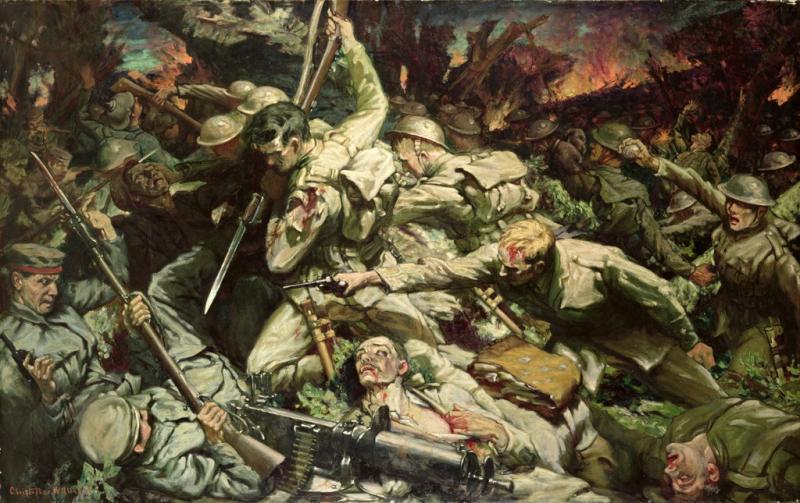-
Welsh at the Somme: The Battle of Mametz Wood
.....
This year marks the centenary of the Battle of the Somme, still one of the bloodiest conflicts the world has ever witnessed. On the first day alone, the British Army suffered a catastrophic 57,470 casualties (1) making it the bloodiest day in their history. World War I, the 'War to end all wars,' as it became known, drew combatants from all over Europe and beyond to take on the might of the German war machine, and the Welsh were at the forefront of it. There is barely a village in Wales without a cenotaph listing the names of the fallen.
The Welsh involvement in the Great War began in earnest with the Battle of Mametz Wood. Historian Dr Robin Barlow says, “Mametz Wood, perhaps like that of Aberfan or Senghenydd, is embedded deep in the Welsh psyche, immediately conjuring up images of needless loss of life, bravery, chaos and self-sacrifice. Hundreds of Welshmen died at Mametz and thousands more were casualties (2)”
Despite the enormous losses on 1 st July, Field Marshal Douglas Haig, Commander of the British Expeditionary Force, was determined that assaults on the German lines should continue. He devised a strategy designed to exploit what small gains the allies had made in the opening exchanges by focusing their efforts on capturing tactically important positions. These included Memetz Wood, an area of dense woodland covering an area of a mile from it's widest point from north to south and three quarters of a mile from east to west, which was being defended by the much-feared Lehr Regiment of the Prussian Guard.
After a few probing mini-attacks and a sustained period of artillery fire designed to wipe out the ranks of waiting machine-gunners, Haig gave the order to advance and at 08:30 on July 7 th 1916 the 16 th Battalion of the Welsh regiment and the 11 th Battalion of the South Wales Borderers went over the top. Also involved in the coming days were 38 th (Welsh) Division comprised of 20,000 volunteers, and 17 th Division, which incorporated several battalions of the Royal Welch Fusiliers. One of their number, an officer named Siegfried Sassoon, described moving across open ground with the wood, “Looming on the opposite slope... a dense wood of old trees and undergrowth... a menacing wall of gloom.”
The majority of fighting men were amateurs who had volunteered expecting the war to be 'over by Christmas,' rather than seasoned veterans. They had precious little training and there was a shortage of basic equipment. Many of the men had never even fired a rifle before leaving for France. In training they had used broomsticks. By contrast, the elite Lehr Regiment were armed with mortars and heavy machine guns and were firmly entrenched in the wood. As the official history commented, “The task that lay before the Division was one of some magnitude (2).”
The first advance was easily repelled, as was another later in the day. By nightfall, 177 men and three officers lay dead or dying. One of these was Corporal Frederick Hugh Roberts, a Senghenydd miner originally from Bethesda, who had enlisted in the 16 th Battalion, Welsh Regiment, early in the war. He had already cheated death once before when a successful bet on a horse led to a heavy drinking session which kept him away from the pit on 17 th October 1913 when the worst mining disaster in British history killed 439 of his colleagues. In France, his luck finally ran out. Llewelyn Wyn Griffith, a captain in the Royal Welch Fusiliers and later a respected novelist wrote, “It was nearly midnight when we heard that the last of our men had withdrawn from that ridge and valley, leaving the ground empty, save for the bodies of those who had to fall to prove to our command that machine guns can defend a bare slope.”
Field Marshal Haig laid the blame for the failed attack squarely on the Welsh Division for not advancing with, “Determination to the attack,” and consequently the divisions commanding officer, Major General Philipps, was relieved of his duties and replaced with Major General Watts, whose first task was to prepare for another attack on Memetz Wood on 10 th July. Stung by the criticism and eager to exact revenge for their slaughtered comrades, the remaining combined forces were now an altogether different proposition. The attack began with a forty-minute bombardment and the laying of a smoke screen to provide cover for the 16 th Battalion of the Royal Welch Fusiliers who attacked the wood from the left-hand side at 04:15. They were soon joined by the 14 th Battalion of the Royal Welch Fusiliers and two battalions of the Welsh Regiment. Then, amongst the smoking tree stumps, fallen branches, and coils of lethal barbed wire, followed some of the most intense hand-to-hand fighting imaginable. A painting by celebrated Welsh artist Christopher Williams (4) gives us some idea of the carnage (5).
The ferocity of the fighting was described by Emlyn Davies of the 17th Battalion, Royal Welch Fusiliers, who had entered the battlefield during the afternoon, and retold by author Jonathan Hicks in his book, The Welsh at Memetz Wood (6): “Gory scenes met our gaze. Mangled corpses in khaki and in field-grey; dismembered bodies, severed heads and limbs; lumps of torn flesh half way up the tree trunks; a Welsh Fusilier reclining on a mound, a red trickle oozing from his bayoneted throat; a South Wales Borderer and a German locked in their deadliest embraces – they had simultaneously bayoneted each other. A German gunner with jaws blown off lay against his machine gun, hand still on its trigger.”
Men and boys fought side by side against their much better trained and equipped German counterparts, those killed in action ranging from 19-year old Private David John Williams of the 16th Battalion Welsh Regiment from Whitchurch, Cardiff to 45-year old Private William Davies of the 13th Battalion, who had volunteered when war broke out and left a widow and four children in Pontypool. Social class also made little difference, as public schoolboys and the sons of scholars fought alongside farm labourers and coal miners. Confusion reigned, and panicked attackers and defenders often mistakenly turned their weapons on their own side. The fighting raged for days, the woods turning into a huge open grave, until eventually the opposition began to crack under the pressure. The tide of the battle turned in favour of the gallant Welsh, and German soldiers began to surrender. The Battle of Memetz Wood was over. During the offensive, the Welsh Division captured a total of 352 Prisoners of War. When the 38 th Division were relieved on the 12 th July, the wood was in British hands, but it came at a terrible cost. The 38 th Division was virtually obliterated and suffered some 4000 casualties, with many of the bodies never being recovered. When it was withdrawn from the line, the division ceased to exist as a viable fighting unit.
Today, visitors to the site of the battle, and maybe the ghosts of the dead, can see one of the most striking war memorials in existence, a huge red dragon standing proud atop a three-metre plinth (7). Erected in 1987 by Welsh sculptor David Petersen, the memorial was commissioned by the South Wales branch of the Western Front Association following a public fund-raising appeal and now stands in tribute to the fallen Welsh of the Somme. We will remember them.
References:
(1): https://en.wikipedia.org/wiki/Battle_of_the_Somme
(2): http://www.walesonline.co.uk/news/wales-news/welsh-history-month-mametz-wood-2047333
(3): http://walesinthefirstworldwar.typepad.com/wales_in_the_first_world_/welshmen-on-the-somme/
(4): https://en.wikipedia.org/wiki/Christopher_Williams_(Welsh_artist)
(5): https://museum.wales/art/online/?action=show_item&item=1955&img=large
(6): http://www.gwales.com/goto/biblio/en/9781784612382/
(7): http://www.greatwar.co.uk/somme/memorial-38-division.htm
-
About The Author
New Tredegar-born C.M. Saunders began writing in 1997, his early fiction appearing in several small-press titles. Following the publication of his first book, Into the Dragon's Lair – A Supernatural History of Wales (2003) , he worked extensively in the freelance market, contributing to over fifty international publications including Fortean Times , Loaded , Record Collector , Nuts . In addition, he has written several novellas and had over thirty short stories published in various magazines, ezines and anthologies. He taught English and creative writing in China for five years, before settling in London where he works as a writer and editor in the sport, fitness and men's lifestyle sectors. He is represented by Media Bitch literary agency.
Sker House: A Novel, is available now:
Drop by my Website:
Or follow me on Twitter:
-
-








